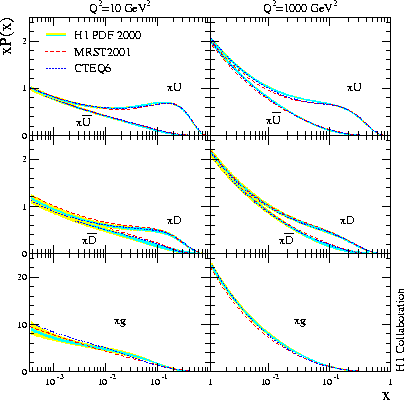Measurement and QCD Analysis of Neutral and Charged Current Cross Sections
at HERA
|
The H1 experiment at HERA was designed to measure the
details of proton sub-structure at the very highest energies using positrons
(e+) and electrons (e-), as probes.
During almost one decade of data taking of the first phase of HERA operation
(HERA-I) from 1992 to 2000, several important data samples were collected
by the H1 experiment at centre-of-mass energies of 319 GeV and 301 GeV
resulting from collisions of positrons/electrons of 27.6 GeV with protons
of 920 GeV and 820 GeV.
Two reactions have been measured in this paper:
The Neutral Current (NC) process where a positron scatters off
a quark via the
exchange of the electrically neutral photon or
Z boson and the Charged Current (CC) reaction where
the positron scatters via the exchange of a charged W
boson and converts
into an unseen neutrino.
This paper constitutes the highest statistics measurement of positron induced
cross sections at high photon virtuality (Q2)
using data collected during 1999 and 2000.
The measurement spans the range in Q2 from 100 GeV2
up to 30000 GeV2.
The cross sections are compared with
an earlier measurement
based on the data
taken from 1994 to 1997 at 301 GeV by H1 using positrons in
a similar kinematic
range. These results, together with those based on the
e-p
data
, complete the H1 measurements of the inclusive cross sections at high
Q2 from HERA-I.

The NC and CC cross section data in e+p and e-p
scattering are complementary in probing different types of
quark inside the proton.
In this paper, the H1 experiment has been used to explore
this complementarity. The huge kinematic coverage of the
high Q2 data, together with equally precise recent
low Q2
data have allowed a determination of the
behavior of quark and
gluon parton distribution functions (PDF),
using H1 data alone. Five components of proton structure are extracted
simultaneously. The first is the up-type quark density, U,
corresponding
to up quarks together with their heavier cousins, the charm quarks. Secondly,
there is the down-type quark density, D, corresponding to the sum of
down and strange quarks. The anti-up-type (Ubar) and
anti-down-type (Dbar) quarks make up the third and fourth components.
The fifth type is the gluons that bind the proton together.
The resulting PDFs are shown in the figure.
They are compared with those obtained
by the MRST and CTEQ groups, who perform global fits to deep-inelastic
scattering data together with various other results.
The comparison is remarkably good, given
the many differences in terms of the data sets used, the theoretical
input and the assumptions made.
The NC photon exchange process
measures the sum of all quark densities weighted by their
squared charges. On the other hand,
Z exchange and its
quantum-mechanical interference with the photon measures the
difference between quarks and anti-quarks.
Furthermore, the dominant components of the Z exchange and
interfernce contributions act with opposite sign for positron and electron
scattering and can therefore be separated from photon exchange by comparing
data from the two beam charges.
These properties were exploited in an
earlier H1 publication
to make a first measurement of the xF3
structure function, which basically measures the valence quarks,
carrying the quantum numbers of the proton.
Using the combined e+p 94-00 NC cross section, an improved
measurment is obtained in this paper,
superseding the earlier measurement.
The NC analysis analysis is extended to lower energies of the scattered
electron than has previously been possible. This has allowed a determination
of the longitudinal structure function, FL, for the first time in
this large momentum transfer range. The results are fully consistent
with the prediction for FL obtained from the PDFs extracted in
the fit to the full data.
Last Update 04.04.2003
